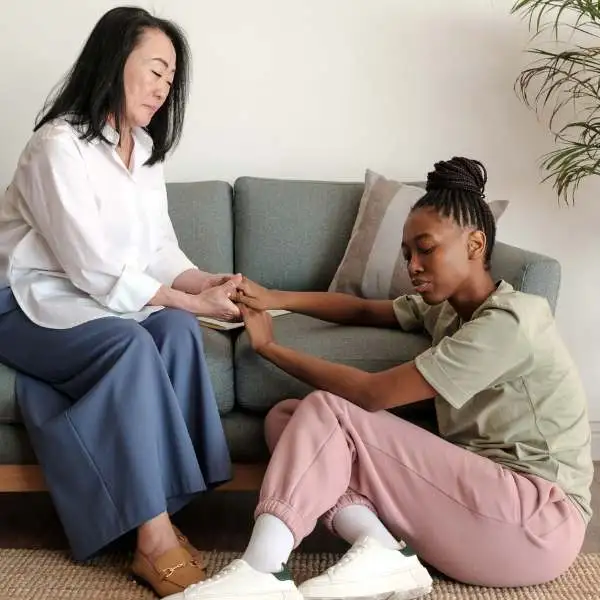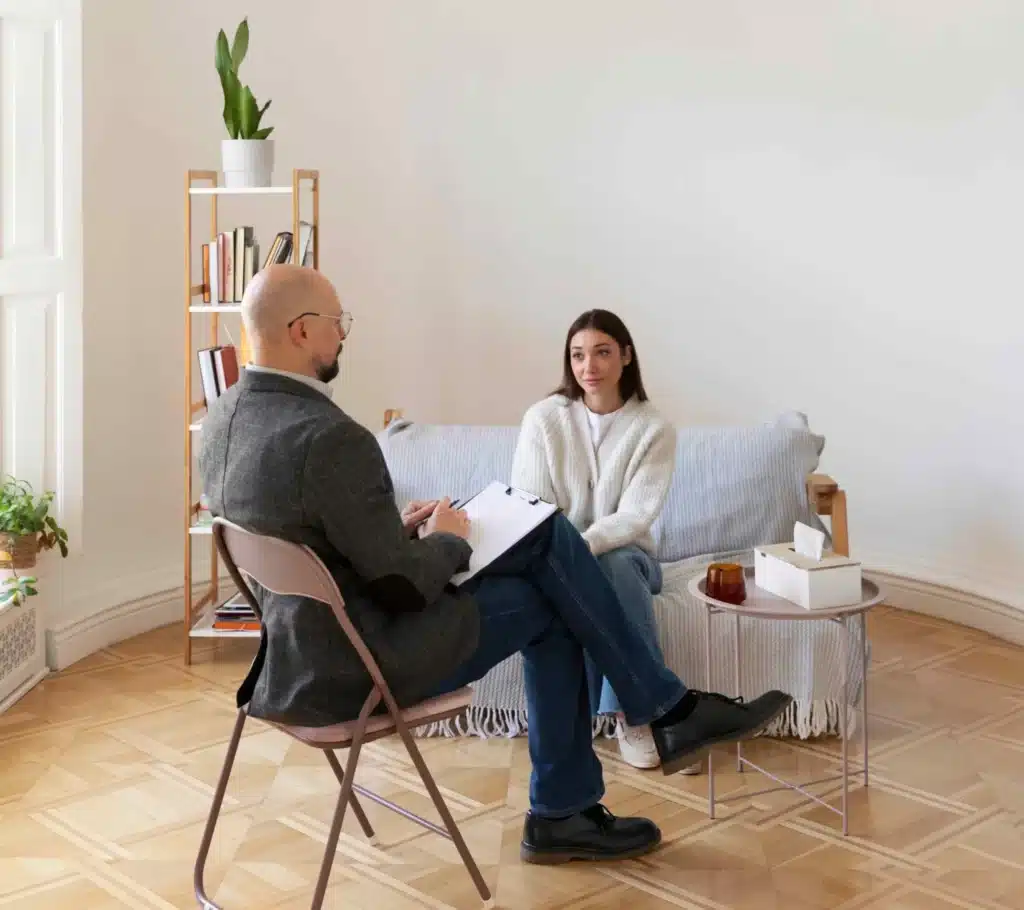Anxiety Therapy
and Counseling Services

From Overwhelming to Manageable: Embrace anxiety therapy in NYC to transform your anxiety from something that feels out of control into something you understand.
Anxiety. It’s a natural human response we all experience. Sometimes, it protects us or helps us succeed. But other times, it rushes in like a tornado, turning our lives upside down and creating chaos in every direction. In these moments, our thoughts seem to turn against us, our breath feels short, and our bodies don’t quite function as we want them to. Simple tasks become monumental challenges, and even hobbies become sources of stress rather than pleasure. But, thankfully, you can discover the power to transform anxiety into a driving force for your life. And we’re here to show you how. Whether you prefer the comfort of your own home or face-to-face sessions in our New York office at Looking Glass NYC, we meet you where you are so you can live a life you love and deserve. Browse our diverse team of experienced therapists, gain direct access to their calendars, and schedule a FREE 10-minute consultation to receive a path forward.Finding a Therapist for Anxiety in NYC
Feeling pulled in countless directions? Maybe you’re struggling with tough choices in your career, friendships, or love life. It’s easy to feel overwhelmed and unsure of what steps to take next.
You might be feeling like anxiety is getting in the way, preventing you from reaching your full potential, achieving your goals, and seeing the positives in each day.
While anxiety is a normal response, too much of it can feel challenging to navigate.
The good news is that it doesn’t have to run your life. With the help of a trusted mental health professional, you can find the light, heal, and take control of your life again.
At Looking Glass NYC, we personally match you with therapists based on your specific needs, preferences, values, sexuality, language, and cultural background.
If you’re ready to find the therapist you’ve been looking for…
- Call our office (646) 760-3399
- Text us on a HIPAA-compliant text line
- Email us info@LookingGlassNYC.com
- Chat with us on Klara
- Or schedule a FREE call with our intake coordinator for guidance
What is Anxiety Therapy?
Anxiety therapy is a specialized form of treatment designed to help you manage and overcome anxiety disorders. You work closely with a trained therapist who provides guidance, support, and practical strategies to address specific symptoms and challenges.
Sessions may involve exploring the root causes of your anxiety, such as negative thought patterns or limiting beliefs, learning coping skills, and developing tools to handle stress effectively.
The ultimate goal is to empower you to regain control over your thoughts, emotions, and behaviors.

When to Seek Help for Anxiety
If you find yourself constantly worrying, experiencing panic attacks, avoiding social situations, or feeling overwhelmed by stress, therapy can provide valuable support. Seeking help early can improve your quality of life, allowing you to enjoy each day more fully.
Types of Anxiety Disorders
Anxiety can affect people in many ways. It is a common emotion characterized by feelings of apprehension, fear, and worry. There are many types of anxiety disorders, including generalized anxiety disorder (GAD), panic disorder, social anxiety disorder (SAD), obsessive-compulsive disorder (OCD), post-traumatic stress disorder (PTSD), phobias, and separation anxiety.
Imagine waking up with a sense of dread coming out of nowhere. You know you have responsibilities, but everything feels difficult—your mind races with worries about everything and nothing at the same time. Even when you try to relax, your body remains tense, your heart pounds, and you feel a constant sense of unease. This example is what living with Generalized Anxiety Disorder (GAD) feels like—an invisible weight that affects every aspect of your life.
Let’s say you’re at the grocery store. Yet, out of nowhere, your heart starts racing, your chest tightens, and you feel like you can’t breathe. Your vision narrows, and a wave of intense fear washes over you, making you think you’re having a heart attack or losing control. You abandon your cart and rush outside, but this uncued panic attack doesn’t go away. This overwhelming terror can strike at any time without warning or a clear cause, leaving you constantly on edge, fearing the next attack. This is life with panic disorder, where everyday activities can suddenly turn into frightening experiences.
Do you ever feel like everyone in the room is watching your every move, judging your every word? Your palms sweat, your face flushes, and your heart pounds so loudly you wonder if others can hear it. You want to join a conversation, but the fear of being embarrassed or rejected is paralyzing. You may have social anxiety disorder (SAD), where social interactions feel like a minefield of potential humiliation, making it difficult to connect with others and enjoy…life.
Imagine you’re about to leave your house, but you can’t shake the feeling that something is wrong. You check the lock on the door once, twice, then again and again, each time convincing yourself it might not be secure. Once you finally get in your car, you drive halfway to work before the doubt creeps in again. Did you really lock the door? Turn off the stove? You drive back home to check, making you late for work once more. This is life with Obsessive-Compulsive Disorder (OCD), where challenging thoughts and constant behaviors consume your time and energy.
If certain sounds, smells, or sights instantly transport you back to a moment of intense fear or trauma, you might be experiencing Post-Traumatic Stress Disorder (PTSD). This reaction isn’t just discomfort; it’s a flashback to a past event. You try to stay grounded, but the memories flood back with such intensity that it feels like you’re reliving the experience. Living with PTSD means the past intrudes on the present, making it difficult to find peace and safety in everyday situations.
Do you ever feel like a certain object or situation has a hold over you? For example, if you have an intense fear of heights, every time you approach a tall building or even see a high balcony, your heart races, your palms get clammy, and you feel a deep sense of panic. It’s not just a temporary discomfort; it’s a crippling fear that makes it nearly impossible to function. You avoid situations where you might encounter heights, missing out on experiences and opportunities. If this sounds like you, you might be living with a phobia.
Imagine feeling panic every time a loved one leaves the room, even just for a few minutes. You constantly worry about their safety and fear something terrible might happen to them while they are away. When your partner goes to work or your child goes to school, you feel overwhelmed, and it becomes difficult to focus on anything else. This intense fear of being separated from loved ones and the constant worry about their well-being is what it’s like living with Separation Anxiety Disorder, where the thought of being apart creates severe distress.


What Does Anxiety Feel Like?
In general, anxiety can feel like a persistent sense of unease that impacts both your body and mind.
Physically, it might manifest as:
- Rapid heartbeat
- Sweating
- Trembling or shaking
- Shortness of breath or a feeling of choking
- Dizziness or lightheadedness
- Stomach upset or nausea
- Muscle tension or aches
Mentally and emotionally, anxiety often involves:
- Excessive worry or fear about everyday situations
- Difficulty concentrating or feeling like your mind is going blank
- Irritability or restlessness
- Trouble sleeping or staying asleep
- Feeling on edge or fearing the worst
Who Can Develop an Anxiety Disorder?
Anxiety disorders can affect anyone. So, if you find yourself feeling overwhelmed by worry that interferes with your daily life, you could be experiencing an anxiety disorder. It’s important to remember that anxiety is a common experience, and seeking help is a sign of strength.

Anxiety & Co-Occurring Mental Health Conditions
Anxiety often doesn’t come alone—it can co-occur with other mental health conditions like depression, ADHD, or substance abuse. When these conditions overlap, they can intensify feelings and make it harder to cope.
Understanding how anxiety interacts with other mental health issues can help you and your anxiety therapist develop a holistic plan for improving your well-being.

About Anxiety Therapy at Looking Glass NYC
Looking Glass NYC uses evidence-based therapies to help you recover from your anxiety disorder and other mental health conditions. We may use a variety of different types of evidence-based therapies to achieve your goals, or even mix them and blend them to suit your learning style, personality, and personal needs.
Please take a look at our evidence-based therapies approved and available for people suffering from different types of anxiety.
Imagine feeling anxious about a job interview to the point where you avoid applying altogether. CBT teaches you to recognize negative thought patterns and replace them with more realistic, positive ones. For example, it might challenge the belief that “I always mess up interviews” with “I have skills and experience that make me a strong candidate.”
If you’re afraid of public speaking, exposure therapy gradually exposes you to speaking situations in a safe, controlled environment. By facing your fears in small steps, like giving a short talk to friends or colleagues, you discover that anxiety lessens over time. This therapy for anxiety helps you build confidence and reduces the fear associated with specific situations.
DBT combines traditional CBT techniques with mindfulness and acceptance strategies. For example, if you struggle with intense emotions that lead to anxiety, DBT helps you learn to tolerate distress and regulate your emotions. It teaches skills like mindfulness to cope with anxiety in relationships and daily life.
In a busy world, MBSR teaches you to pause, breathe, and be present in the moment. Using various grounding techniques, you notice and accept thoughts and feelings without judgment. For instance, a regular mindfulness practice quiets past regrets and future worries, emphasizing the importance of living in the now.
When anxiety significantly impacts daily life, medication therapy might be prescribed by your therapist.
About Anxiety Therapy at Looking Glass NYC
At Looking Glass NYC, we understand that everyone experiences anxiety differently and for different reasons. That’s why our therapists take a tailored and customized approach when creating treatment plans to help you manage and reduce your anxiety symptoms. We work closely with you to assess your specific needs and goals and create a treatment plan based on these factors.
At Looking Glass NYC, we strive to provide accessible mental health services that are both affordable and tailored to you. Our team of will work with you every step of the way to help you manage your anxiety symptoms and develop skills to cope with them more effectively

Anxiety Therapy FAQs
During your first therapy session at Looking Glass, you can expect to discuss your reasons for seeking therapy, your current challenges or concerns, and what you hope to achieve. We’re dedicated to creating an environment where you feel seen, heard, and understood.
The length of therapy varies depending on your individual needs and goals. Some people benefit from short-term therapy focused on specific issues, while others may find long-term therapy helpful for ongoing support and personal growth. Your therapist will work with you to determine the most suitable duration based on your progress and preferences.
Virtual therapy offers the convenience of attending sessions from the comfort of your home or any private space. Using a secure video conferencing platform, you can connect with your anxiety therapist to receive personalized support and guidance.
Choosing the right therapist involves considering factors like their specialization, approach to therapy, personality, language, and availability. We provide information about each therapist’s background and specialties, supporting you to make the best decision.
Alternatively, you can also schedule a FREE call with our Intake Coordinator to guide your decision-making process. They will help you find a therapist aligned with your goals.
You’ll experience positive changes from the very first session! You and your anxiety therapist will track your progress toward your goals and positive shifts in your thoughts and behaviors.
We accept a variety of health insurance plans to make therapy more accessible. Contact our intake coordinator to learn if your insurance plan is accepted.
As soon as you need. Book a FREE ten minute consultation with us by browsing our library of skilled therapists, text or call our main office line, (646) 760-3399, emailing us, or scheduling a FREE call with our intake coordinator. We offer flexible scheduling to accommodate your needs.
Feeling anxious and struggling to navigate your daily life? We’re here to guide you back to a place of calm and confidence.
Book a session now and take the first step towards a more grounded, resilient you.
Trusted Experts
Match with your perfect NYC Therapist
-
 Dr. Gindy is wonderful. My life has changed dramatically for the better. My mental health along with my personal development has taken huge leaps forward in such a short period. My time spent with Dr. Gindy is invaluable. My only regret is not meeting her sooner.
Dr. Gindy is wonderful. My life has changed dramatically for the better. My mental health along with my personal development has taken huge leaps forward in such a short period. My time spent with Dr. Gindy is invaluable. My only regret is not meeting her sooner.










